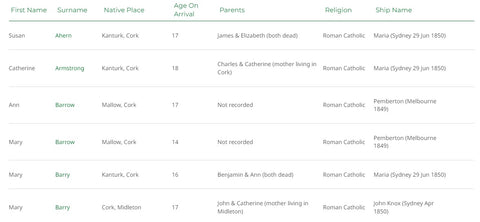4000 adolescent female orphans emigrated from Irish workhouses to the Australian colonies, arriving at Sydney, Melbourne and Adelaide between 1848 and 1850.
Their emigration became known as the ‘Earl Grey scheme’ after its principal architect, Earl Grey. Many of the 4,000 teenagers faced anti-Irish sentiment, discrimination and abuse, but were a resilient group.
The first orphans girls arrived from Ireland aboard the Lady Kennaway on September 11th, 1848. Most of the girls were from counties Mayo, Galway, Sligo and Donegal, and many were native Irish (Gaelic) speakers.
A total of six ships, Pemberton, the Lady Kennaway, Diadem, New Liverpool, Derwent and Eliza Caroline, sailed across the world with 4,000 Irish Famine orphan girls, 1,700 of them arriving in Melbourne.

Earl Grey (1802-1894)
Secretary of State for War and the Colonies
The orphans had an important - still widely unknown - role in the Australian story, and one which countless Australians can claim in their own family story.
The Irish Potato Famine / Great Hunger had decimated the population of Ireland, resulting in more than one million deaths and two million emigrants forced to flee starvation and disease.
The Earl Grey scheme took girls aged from 14 to 19 from workhouses across Ireland to work in Australia as servants, and to help populate the new colony.
After the horror of starvation and loss of family and home in the Irish Famine, surviving the destitution of the infamous workhouses and enduring an arduous sea voyage, the orphans reached a strange and intimidating new land. But they must also have had feelings of hope and optimism.


Russell Blanch, left, and his Irish ancestor Eliza Dooley
Hyde Park Barracks Sydney
Housed at the Immigration Depot, now the Immigration Museum, sisters and friends were soon separated as they were hired-out to work.
Some of the Famine orphans suffered exploitation and abuse from unscrupulous employers, and others fell on hard times. All were subjected to rampant discrimination, as anti-Irish sentiment increased with the arrival of each ship.
According to 1848 records of the Lady Kennaway, the complement of 191 Irish orphan girls were well behaved and in excellent health. They enjoyed the benefit of a full allowance of rations on the 85-day voyage. Although few could read, and almost none could write, they were given a prayer book and testament from their poorhouses.
Nonetheless, most of the Irish Famine orphans flourished – they married and raised families in the harsh conditions of the new colony. Great numbers would live to see the dawn of the new 20th century in their new land.
Sisters Eliza and Catherine Dooley and their cousin Ellen travelled from the Parsonstown Union workhouse in Kings County (Offaly), arriving in Sydney on the Tippoo Saib in July 1850. Eliza, the youngest, was 17. Her parents, from Kilcoleman, were dead. An uncle remained in the workhouse
Staying briefly in the Barracks, Eliza found work as a nursemaid in Maitland and in 1854 married an Englishman John Blanch, eventually raising 13 children.
Within a decade the couple had acquired the ‘Royal Oak Inn’ on the Uralla gold diggings near Armidale.
At one time terrorised by the bushranger ‘Thunderbolt’, whose inquest took place in her Inn, Eliza remained in Uralla until 1891 before moving to Armidale where she died, aged 80, in 1912.

